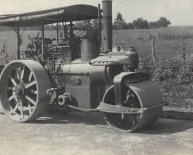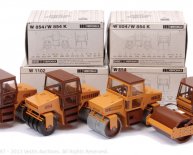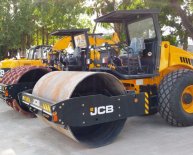
Pneumatic Road Roller
While most contractors might use a steel drum roller to complete their paving jobs, a time can come when rubber-tired rollers might be a consideration. Also called pneumatic rollers, rubber-tired rollers used with steel drum rollers provide contractors with a better base before paving, achieve a better density or compaction, and improve the look of the finished product.
Pneumatic Rollers
Before purchasing a pneumatic roller, contractors should understand the role a rubber-tired roller plays in a paving operation. Compared with using only a steel drum roller, pneumatic rollers have many benefits for contractors.
“On any paving job you need a roller, a lot of guys just use a steel drum roller, ” says Bill Wilkens, engineering manager at Leeboy. “For guys that are getting a little bit bigger, it [pneumatic roller] weighs just a little bit more; in addition it’s versatile. It can be used for paving, and it puts that nice smooth finish into the job. It allows the tire pairs to oscillate for any imperfections in the paving process.”
The manipulation of the asphalt comes from ballasting the pneumatic roller to achieve a specific weight. “The front four tires will rut the material, and along in the back you have five tires that will fit around the four tires, ” says Chris Connolly, Bomag America’s product manager for asphalt. “You’ve created a situation where not only have you vertically put pressure on the material by rutting the material but you’re coming along and counter-rutting.” The effect of the rutting and counter-rutting is the manipulation being used to bring density and stiffness to the material, Connolly says.
Pneumatic rollers help achieve compaction; however, compaction is often a greater concern for larger, highway jobs compared to parking lots.
“Your typical parking lots and driveways are not necessarily as concerned with density as a neighborhood street or highway because they aren’t getting a lot of heavy truck traffic, ” Wilkens says. “The asphalt base may be a little thinner or maybe the subsoil preparation is a little different than the highway so a small roller is there to do compaction but it’s not used to get the real high dense numbers like on the highways.” Regardless of the project, the pneumatic roller helps contractors achieve a consistent density.
Unlike steel drum rollers, pneumatic rollers are able to conform to the surface being paved.
“Using rubber tires that are air inflated and have some ‘give’ conform to the work surface whether it is rolling stone or asphalt, ” says Shannon Chastain, owner of Basic Equipment. “In comparison, a steel drum roller has no ‘give’ to it causing a bridging effect over parts of the work surface. In the design of a rubber-tire roller every wheel on it can oscillate, and in addition, you have the flex and give of the rubber tires as well.”
This is especially useful with patching utility cuts or potholes. By having all-wheel independent movement the pneumatic roller is able to dip down into a depression and compact it much more thoroughly, Chastain says. “No matter what the contour of terrain on the work surface, the pneumatic roller is going to be able to get a more consistent compaction density across the entire work surface, ” he says.
Bruce Monical, marketing manager for Hamm, says contractors using a pneumatic roller can achieve a compaction that will eliminate the voids in the asphalt mix that would otherwise enable potholes to appear.
“One thing that happens when a rubber-tired roller rolls over the top is that it compresses the asphalt, making it more dense, ” Monical says. “There is a side effect with a rubber-tired roller because that rubber-tired roller kneads the hot mix asphalt gently at the surface, driving the bigger stuff lower and bringing the fines to the surface. A side effect to that is it seals the top better.”
According to Monical, if the fines of the hot mix are at the surface the pavement is sealed better, and the chances of water getting into the pavement when it rains decreases.
In most situations, pneumatic rollers are used as the intermediate roller in a paving train following between 50-100 ft. behind the breakdown roller.
“Most guys buy a pneumatic roller to complement their use of a steel drum roller, ” Wilkens says. “They might do some compacting with a steel drum roller, and as they approach the end they may run over that same asphalt with a pneumatic roller to improve the overall finish of the material.”

















